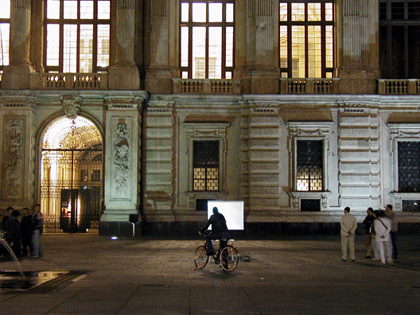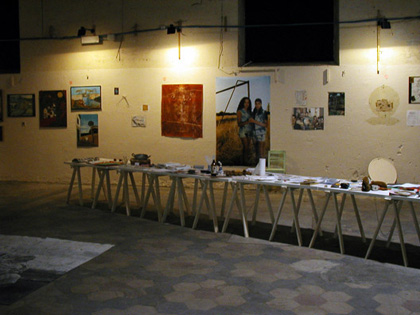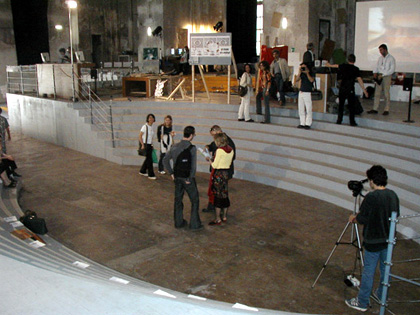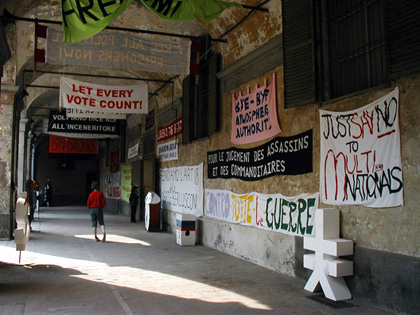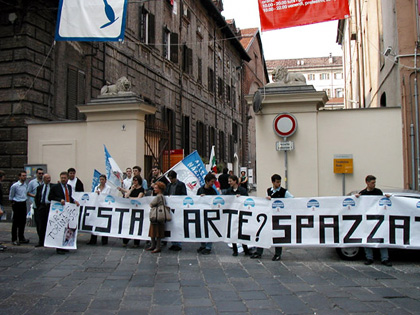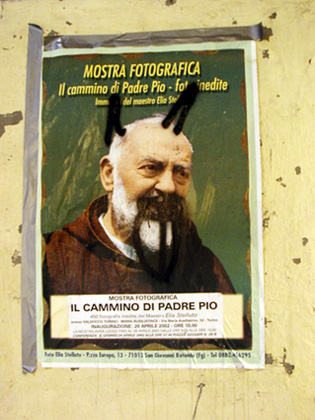return to 16beaver Platform page...
Looking for the BIG Idea
A Report from BIG Torino 2002
by Rene Gabri - 05/20/2002
|
Torino gets an ear/eyeful
of art, politics, noise, and play |
------------------------------------------------------------------
"Journalisms:" or "Our Correspondent:" or "?" The title and mission of
this collective project is a work in progress. But the general idea is
that we cannot be in all places at all times. So those who would like
to can write a "report" or "editorial" or "correspondence" to share experiences
for the benefit of others. To take part or for more information either
visit our submission page or write to journalisms@16beavergroup.org
------------------------------------------------------------------
When I originally thought about writing an article about BIG (Biennale
Internazionale arte Giovane) Torino 2002 for Thing.net/16Beaver, I really
wondered what I could offer. Big show, big budget, too many artists, too
much to possibly summarize fairly. But being a participant in something
like this affords you a view that is different from a journalist who visits
the show. So I have decided to attempt something like a summary article,
which, time permitting, I will follow up with something a bit more specific.
e-Xplo (Erin McGonigle, Heimo Lattner, and I) was invited to propose a
couple of projects for the Biennale and that invitation is what brought
me to Torino. This is week 3 for us here, as we are working on a bus tour
project and open channel events with sound artists working in Torino.
During my stay here, I have been able to familiarize myself with some
of the people involved in organizing the event as well as learn about
a lot of the projects here.
|
|
Since BIG is a part of a more committed ongoing
engagement with this region, it is the product of several different individuals
and visions. Nevertheless, it is without a doubt Michelangelo Pistoletto's
(the artistic director for the 2002 edition of BIG) own aesthetic and
predilection towards a more socially engaged art that have infused this
entire Biennale. From the selection of curators -- which included artists
like calc and Christian Marclay -- to the selection of participating artists,
there seems to be a sincere interest in setting up a counterpoint to the
"ordinary" large-scale exhibitions and biennials being organized today.
The counterpoint is best summarized by Pistoletto himself:
"Art has reached a degree of excellence and sovereignty that I would define
with the paradigm of 'orthodoxy'. As for the great religions, the cathedrals
of art grow ever more numerous and imposing and an auto-referential aura
of artistic mysticism is being diffused. This event aims to be placed
on another side of art itself -- on the 'heterodox' side. This prepares
to meet and intertwine with the ordinary things of life; it mixes with
everyday facts...it is not about applied art, it is about an implicated
art."
|
Benoit Roussel walks
in the city during the day, shoots scenes, edits, shows |
In short, there is a real sense within this
biennale that the artists are actively invited to take on projects that
engage the social in its many different manifestations -- and often in
a playful way. It is not just a theme, but also a provocation, which is
what makes this the proposal interesting.
Before even looking at the context or content of the works, one is first
struck by one thing: Groups easily outnumber individual artists. This
could be read as the first implication of "the social" within the context
of BIG. The range of projects, the approaches in implicating "the social
(game)" and the methods of organization between the many groups varies,
but it seems that the term "platform" could be a useful frame of reference
for this BIG Social Game.
How do platforms get created? How are they used? How open should they
be? Who should be given access? How does a platform that operates through
virtual interfaces translate in the physical city or in physical space?
How can platforms be used/hijacked? What pitfalls do they have? These
are some of the questions I have asked myself when looking at the many
different projects at BIG.
|
Locale Cultura & Colectivo Cambalache navigate through the city with a van meeting people, hitchikers, citizens, non-citizens, bartering goods, creating impromptu happenings, picnics,...this evolving museum of oddities travels from city to city, up next, Istanbul
|
Another implication of "the social game" that
the curators have invoked involves a more committed relation to time and
the city. Many artists have been encouraged to take on projects that engage
the city and its inhabitants, and that will evolve over the length of
their stay here. The list of groups working in this way is quite long:
etoy, slice 252, transnational republic, e-Xplo, reinigungsgesellshaft,
cudi, n55, Hollow Builders.
Juan Esteban Sandoval Arango has set up a newsstand from which over the
course of the month he distributes his own magazine, which attempts to
draw people in with humorously altered versions of popular journals and
papers. At the same time, etoy has set up their large containers in the
Piazza Castello (in the center of town) to operate as a day care center
for kids. Children and school groups are invited to become familiar with
new media and express their creativity.
In the garden behind the exhibition area in Cavalerrizza there is a sculpture/installation
made of 40,000 small blocks of wood by the French group the Hollow Builders.
Visitors are invited to use the blocks to build whatever they would like.
The twist is that the artists are spending the entire month (minus the
rainy days) working alongside the visitors, building and re-building with
the wood blocks, as well as socializing with those passersby who get involved.
More than half of the projects take place within
the city as opposed to the exhibition area proper (all of the artists
named so far for example). There is just no way to summarize this -- the
sheer number of projects is overwhelming -- so any mention of individual
projects can become misleading. In fact, with over 350 artists taking
part, there are approximately 150 projects taking place. The projects
are placed in such diverse categories as visual art, net related art,
music, dance, theater, film, gastronomy, and literature. And given this
diversity, and perhaps like any large show, BIG has the difficult task
of trying to connect what is taking place within the city and what is
happening in the exhibition area proper.
|
A not
so great image of the Arena in the Cavalerriza, but you get the
picture. This |
The weekly program here includes performances (theater, dance, music) and discussions, which invite some of the artists working online or outside the exhibition space to discuss their work with a broader public. Although the attendance to these discussions has been generally consistent, it seems that too much time is devoted to the presentation of work and not enough on the "social" part of the format which would be the discussion and Q & A session.
The biennale has had its fair share of critics,
but their criticism has rarely been directed at enhancing the social components
of their program. The criticism has also not attempted to take on the
fullness of the program, often opting for a reductive and oversimplified
version. In fact, much of the criticism has emanated from some conservative
politicians (Alleanza Nationale) as well as from some the local media.
These critics have tried to find fault in the politicized and agitational
nature of some of the works without at all engaging the merits of the
individual projects, which brings to mind Chris Ofili and Renee Cox this
last year in New York.
|
Lyn Lowenstein imagines an "arcade dedicated to the ideas and concerns of others" |
One of the easy targets has been Lyn Lowenstein's
work, which is ironically one of the only projects in the entire biennale
that uses some of the vocabulary of painting. Her project reproduces political
banners seen in rallies and represented by the media and puts them in
the same space, hoping that in sum they point "toward the potential for
a different world." A quick glance at the work reveals numerous banners:
a cardboard model of the World Trade Center with a plane stuck in one
of them, anti-globalization banners, signs condemning Israeli and US aggression,
and another sign reading "Bin Laden is [the] Best"). The work is provocative,
but it also has a critical sharpness. It is interested in provoking a
dialogue between the potentialities these signs invoke and for putting
these hopes, fears, and demands into play with one other. If it fails
anywhere, it is that it rarely represents viewpoints that would startle
a left-leaning, art-going public.
Not shying away from politically charged and engaged work, BIG has also
invited some controversy (and a few lawsuits) of its own. Dealing with
some of these pressures -- funding for some of Pistoletto's own projects
in the community has already come under fire -- the organizers of the
biennale have also had to walk the fine line of opening up these types
of discussions without completely alienating the local community, corporate
supporters, as well as the regional supporters. The Piemonte region appears
to be surprisingly committed to helping organize and support BIG 2002
as well as last time around.
|
Obviously not liking
the BIG Idea, a handful of college students
working with right wing political party, Alleanza Nazionale, organize
a protest in front of BIG Torino 2002 Exhibition area. |
This has meant making some difficult decisions.
The group Everyone is an Expert (expertbase.net)
was recently disinvited after refusing to alter some text in their newsletter
"Basta con Berlusconi, Basta con Bossi Finni." The artists believed that
they were being asked to censor themselves. The curators involved in making
the decision believed those lines were neither very interesting nor integral
to the Experts' proposed project. They also felt that the response or
attention this type of statement would elicit would only serve the wrong
platform. Meetings were organized with other artists to discuss the possibilities
and some alternatives were discussed, but in the end, the decision was
made to drop the group from the biennale.
In addition to the Expert situation, rTMark published some harsh statements
about BIG's organizers, intimating that they were not showing enough fortitude
against the likes of Berlusconi. There were yet further allegations that
rTMark had been convinced to sign something promising not to offend anyone.
The agreement they signed placed financial liability upon rTMark for their
actions, protecting BIG from possible lawsuits.
From what I know, many of the invited artists
had to take on liability for the risks inherent in their respective projects,
so I do not think rTMark were being singled out.
Furthermore, if there is any question about the political positions taken
up by the curators of this biennale, one only needs to look at the diversity
and subtlety of the group of projects that have been invited here. In
addition to the qualities I have mentioned (groups/collectives, engagement
with time, process over product, etc...), I am hard pressed to think of
a group exhibition in which I have encountered such an interesting group
of artists engaging social questions from so many different angles.
Unfortunately, this type of negative media attention can only draw time
away from the less immediately provocative works. There can be a plus
side to all of this: I think by forcing the issue, the curators as well
as the artists involved have opened up a space of contestation. Where
does commitment fit into this big social game? What room is left for alliances
or negotiations within these commitments? These questions also relate
back to the earlier questions I raised in relation to platforms. They
are questions of contextuality, compatibility, openness, and limits.
|
This image, which was
a part of Locale Cultura & Colectivo Cambalache's street museum,
stirred up all the would be Guiliani's of Italy including the protestors
shown above. |
So I cannot simply say BIG failed because they
kicked out group A or B; it is a lot more complex than that. I think important
questions have been raised by these actions and the real meat may lie
in thinking and engaging those questions.
From the vantage point of this participating artist, Pistoletto's "Big
Social Game" is not without its problems, but the boldness of vision in
its engagement with an idea of a heterodoxy of art (outside of any problems
we may have with binary oppositions) is to be commended, worked with,
and further developed. There is a vitality here that is missing from many
other big art shows, and that vitality is most felt with the works that
are out there in the streets, in piazzas, online, in the newspaper stands,
the gardens, the city buses (yes there are other artists working with
buses). The curators involved have selected a very interesting set of
artists/groups/projects, and although the works are not always easy to
locate and sometimes miss the mark, more often than not they engage the
theme of this Biennale. They add to a greater discussion of art and its
engagement with society, an art more implicated than applied.
www.bigtorino.net
www.bigtorino.net/english
www.bigguest.net
www.afterall.tv
calcaxy.com
cittadellarte.it
de-lete.tv
distributive-justice.com
etnicitta.it
etoy.com
expertbase.net
e-xplo.org
http://reroute.c3.hu
lasagencias.net
logicaland.net
My Cat is An Alien
n55.dk
onair.co.za/safefood
pettek.org
rtmark.com
slice252.org
superflex.dk
trnr.org
<<<back to index
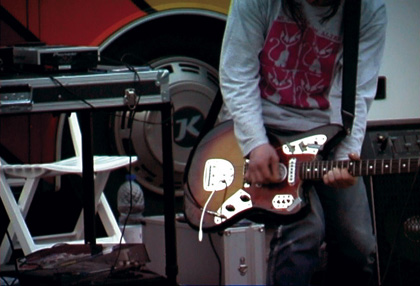
 Fabrizio Palumbo, Maurizio & Roberto Opalio
from My Cat is an Alien
Fabrizio Palumbo, Maurizio & Roberto Opalio
from My Cat is an Alien 